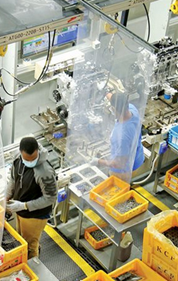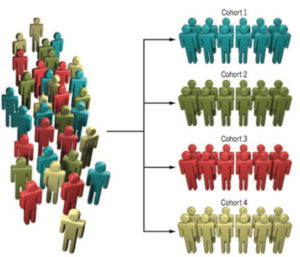Covid-19 Manufacturing Operations: Control Practices to Adopt
Dave Unmacht, Senior Risk Specialist at ABR Employment Services, closely monitors and updates ABR staff on safe workplace operations. As your manufacturing workforce solutions partner, we have a dual responsibility to ensure the health and safety of all worksite employees, temporary and permanent staff alike.
As you know, manufacturing employees often work close to one another on production or assembly lines or when clocking in or out, during breaks, or in locker/changing rooms. Employees often have prolonged closeness to coworkers, between 8 – 12 hours depending on work shifts.
The Silent Spread
By now we are familiar with how the Covid-19 virus spreads; through respiratory droplets in the air from a cough or sneeze. Exposure could also occur from contact with contaminated surfaces or objects, such as tools, workstations, or break room tables, to name a few. Shared spaces such as break rooms, locker rooms, and entrances/exits to the facility may also contribute to virus exposure.
The CDC and OSHA continue to develop and update their guidance regarding manufacturing facility operation during Covid-19. Dave has read through the guidance and summarizes key Covid-19 control practices to implement below.
Note, this summary is not intended for use as a full operations plan for your facility. Consult with your state and local public health officials and occupational safety and health professionals to develop your manufacturing operations plan.
Covid-19 Manufacturing Operations: Control Practices to Adopt
Engineering Controls

- Change production practices to maintain appropriate distances among workers
- Modify the alignment of workstations so workers are at least 6 feet apart in all directions (e.g., side-to-side and when facing one another). Ideally, modify the alignment of workstations so that workers do not face one another
- Use markings and signs to remind workers to maintain their distance at their work station and remind to practice social distancing on breaks
- Use physical barriers, such as strip curtains, plexi-glass, or partitions to separate manufacturing workers from each other, if feasible
- Consider consulting with a heating, ventilation and air conditioning engineer to ensure adequate ventilation to help minimize potential exposures
- If fans are used in the facility, take steps to minimize air from fans blowing from one worker directly at another worker
- Personal cooling fans should be removed from the workplace to reduce the potential spread of any airborne viruses
- If fans are removed, employers should remain aware of, and take steps to prevent heat related hazards
- Place hand washing stations or hand sanitizers with at least 60% alcohol in multiple locations to encourage hand hygiene. If possible, choose hand sanitizer stations that are touch-free
- Add additional clock in/out stations, if possible, that are spaced apart, to reduce crowding. Consider staggering times for workers to clock in/out
- Remove or rearrange chairs and tables, or add partitions to tables, in break rooms, and other areas workers may frequent to increase separation
Administrative Controls
- Limit facility access
- If meetings must be held, such as at shift changes, break them into smaller groups instead of holding a larger meeting
- Eliminate non-essential meetings
- Encourage single-file movement with a 6-foot distance between each employee through the facility, where possible
- Designate workers to monitor and facilitate distancing on production or assembly line floors
- Stagger break times
- Stagger workers’ arrival and departure times to avoid congregations of workers in parking areas, locker rooms, and near time clocks
- Provide visual cues (e.g., floor markings, signs) as a reminder to workers to maintain social distancing
- Encourage workers to avoid carpooling to and from work, if possible

Cohorting Employees (Grouping Together)
- Make sure that groups of workers are always assigned to the same shifts with the same coworkers
- Cohorting minimizes the number of different individuals who come into close contact with each other over the course of a week, potentially reducing the number of workers outside of the cohort being exposed
Keep Employees Safe – Download & Display Posters
A number of free print materials are available for download on the CDC website in English and 27 other languages. The materials are developed to support COVID-19 recommendations. They may be printed on a standard office printer, or through a commercial printer.
The CDC recommends all manufacturing facilities develop plans for operations during COVID-19. Consult with your state and local public health officials and occupational safety and health professionals to develop your manufacturing operations plan.
Thank you for your continued partnership and for your tireless efforts to protect the health and safety of employees.
